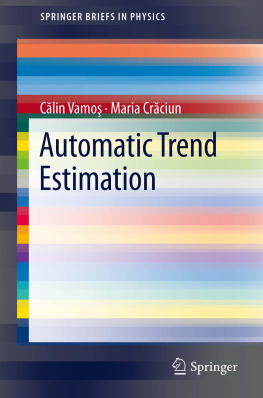Craciun Maria - Automatic trend estimation
Here you can read online Craciun Maria - Automatic trend estimation full text of the book (entire story) in english for free. Download pdf and epub, get meaning, cover and reviews about this ebook. City: Dordrecht, year: 2013, publisher: Springer Netherlands, genre: Home and family. Description of the work, (preface) as well as reviews are available. Best literature library LitArk.com created for fans of good reading and offers a wide selection of genres:
Romance novel
Science fiction
Adventure
Detective
Science
History
Home and family
Prose
Art
Politics
Computer
Non-fiction
Religion
Business
Children
Humor
Choose a favorite category and find really read worthwhile books. Enjoy immersion in the world of imagination, feel the emotions of the characters or learn something new for yourself, make an fascinating discovery.
- Book:Automatic trend estimation
- Author:
- Publisher:Springer Netherlands
- Genre:
- Year:2013
- City:Dordrecht
- Rating:4 / 5
- Favourites:Add to favourites
- Your mark:
Automatic trend estimation: summary, description and annotation
We offer to read an annotation, description, summary or preface (depends on what the author of the book "Automatic trend estimation" wrote himself). If you haven't found the necessary information about the book — write in the comments, we will try to find it.
Craciun Maria: author's other books
Who wrote Automatic trend estimation? Find out the surname, the name of the author of the book and a list of all author's works by series.










 the random variable
the random variable  takes the value
takes the value  . We follow the practice of denoting by small letters the realizations of the random variable denoted by the corresponding capital letters. Throughout this book we consider only continuous random variables with real values. If the random variable is absolutely continuous, then it has a probability density function (pdf) denoted
. We follow the practice of denoting by small letters the realizations of the random variable denoted by the corresponding capital letters. Throughout this book we consider only continuous random variables with real values. If the random variable is absolutely continuous, then it has a probability density function (pdf) denoted  . The cumulative distribution function (cdf)
. The cumulative distribution function (cdf)  is the probability that the random variable
is the probability that the random variable  takes on a value less than or equal to
takes on a value less than or equal to  . We denote the mean of the random variable by
. We denote the mean of the random variable by  and its variance by
and its variance by  .
. defined on the same probability space and indexed by a set of real numbers
defined on the same probability space and indexed by a set of real numbers  . In this book we study only discrete stochastic processes for which
. In this book we study only discrete stochastic processes for which  contains equidistant sampling moments. The observations are made at discrete time moments
contains equidistant sampling moments. The observations are made at discrete time moments  , where
, where  ,
,  is the sampling interval, and
is the sampling interval, and  is the initial time. The observed values
is the initial time. The observed values  are realizations of the corresponding random variables
are realizations of the corresponding random variables  . Although the number of observations is always finite, we assume that there is an infinite stochastic process
. Although the number of observations is always finite, we assume that there is an infinite stochastic process  whose realizations for
whose realizations for  and
and  have not been observed. To distinguish between the infinite stochastic process which models the time evolution of the natural phenomenon and its measurements, we call time series the finite sequence of real numbers
have not been observed. To distinguish between the infinite stochastic process which models the time evolution of the natural phenomenon and its measurements, we call time series the finite sequence of real numbers  .
. is the probability that their values are smaller than some given values
is the probability that their values are smaller than some given values 
 and
and  . For absolutely continuous random variables there exists the joint pdf
. For absolutely continuous random variables there exists the joint pdf  . A stochastic process is (strictly) stationary if for every index vector
. A stochastic process is (strictly) stationary if for every index vector  and integer
and integer  we have
we have  or
or  , where
, where  , i.e., its joint probabilities do not change under temporal translations. From this definition, for
, i.e., its joint probabilities do not change under temporal translations. From this definition, for  it follows that all the components of a stationary process have the same probability distribution
it follows that all the components of a stationary process have the same probability distribution  for all integers
for all integers  . Such a stochastic process is called identically distributed .
. Such a stochastic process is called identically distributed .